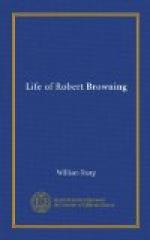In the summer of 1834, that is, when he was in his twenty-second year, he returned to Camberwell. “Sordello” he had in some fashion begun, but had set aside for a poem which occupied him throughout the autumn of 1834 and winter of 1835, “Paracelsus.” In this period, also, he wrote some short poems, two of them of particular significance. The first of the series was a sonnet, which appeared above the signature ‘Z’ in the August number of the Monthly Repository for 1834. It was never reprinted by the author, whose judgment it is impossible not to approve as well as to respect. Browning never wrote a good sonnet, and this earliest effort is not the most fortunate. It was in the Repository also, in 1835 and 1836, that the other poems appeared, four in all.
The song in “Pippa Passes,” beginning “A King lived long ago,” was one of these; and the lyric, “Still ailing, wind? Wilt be appeased or no?” afterwards revised and incorporated in “James Lee,” was another. But the two which are much the most noteworthy are “Johannes Agricola” and “Porphyria.” Even more distinctively than in “Pauline,” in their novel sentiment, new method, and generally unique quality, is a new voice audible in these two poems. They are very remarkable as the work of so young a poet, and are interesting as showing how rapidly he had outgrown the influence of any other of his poetic kindred. “Johannes Agricola” is significant as being the first of those dramatic studies of warped religiosity, of strange self-sophistication, which have afforded so much matter for thought. In its dramatic concision, its complex psychological significance, and its unique, if to unaccustomed ears somewhat barbaric, poetic beauty, “Porphyria” is still more remarkable.
It may be of this time, though possibly some years later, that Mrs. Bridell-Fox writes:—“I remember him as looking in often in the evenings, having just returned from his first visit to Venice. I cannot tell the date for certain. He was full of enthusiasm for that Queen of Cities. He used to illustrate his glowing descriptions of its beauties, the palaces, the sunsets, the moonrises, by a most original kind of etching. Taking up a bit of stray notepaper, he would hold it over a lighted candle, moving the paper about gently till it was cloudily smoked over, and then utilising the darker smears for clouds, shadows, water, or what not, would etch with a dry pen the forms of lights on cloud and palace, on bridge or gondola on the vague and dreamy surface he had produced. My own passionate longing to see Venice dates from those delightful, well-remembered evenings of my childhood.”




